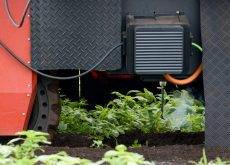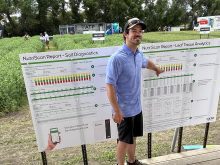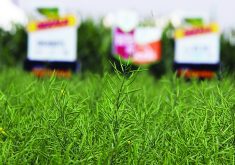Surfactants have come a long way since the days of diesel and dish detergent mixes.
Lecithin has been an important ingredient for decades, but its role within a surfactant mix isn’t always well understood.
The surfactant LI 700 by Loveland depends on a formula called Leci-Tech, which has lecithin as the main component. According to literature from UAP, LI 700 provides six benefits:
- better spreadability so the active ingredient in the pesticide has better contact with the leaves
- improved adhesion so the product remains on the leaves
- enhanced breakdown of the waxy coating so the product penetrates the protective outer surfaces
- less cell wall disruption on the plant surface improves crop health
- environmentally friendly because it is made from soybean oil
- droplet management, one of the chief factors in controlling drift and off-target spray, is enhanced by lecithin
Read Also

VIDEO: Case IH reveals new Optum tractor at Agritechnica 2025
Case IH reveals its new Optum tractor at Agritechnica 2025.
UAP said its LI 700 is the only penetrating surfactant that is labelled to have a lower potential of off-target spray. Studies conducted at Agriculture Canada’s research centre in Saskatoon support its claim, said application technology researcher Tom Wolf.
“In our research, LI 700 had a very interesting ability to change droplet size,’’ said Wolf.
“It reduced the number of driftable fine droplets in the spray without increasing the number of big droplets. And that’s odd.”
Wolf said it’s necessary when reducing drift to reduce the number of those fine droplets, which are slow moving and do not carry enough weight to hold their trajectory in a breeze.
Farmers who wanted to reduce spray drift would traditionally use a low-pressure, low-drift nozzle with or without air induction. Reduced internal nozzle pressure reduces the fines.
However, the negative side effect is that reduced internal nozzle pressure increases the number of big droplets, and they are not useful in a spray operation.
“There are normally only a small number of these large droplets, but they hog a large percentage of the spray volume,” said Wolf.
“Think of it as one or two volleyballs mixed in with hundreds of ping pong balls. There are very few volleyballs, but they hold a lot of the product. Their low number means that very few will hit a leaf. But we have lots of ping pong balls, so it’s likely that most of them will hit a target.”
Wolf said small droplets of less than 150 microns account for 15 to 20 percent of the spray volume in a typical spray pattern without low pressure. These are the fine droplets that are prone to stray from the target.
Large droplets bigger than 600 microns account for five to 10 percent of the spray volume. They have little benefit for the spray operation because there are so few of them, and little of their liquid ends up on the target.
“If we go to low-drift nozzles, we go from 15 to 20 percent driftables down to five percent driftables. That’s a two-thirds reduction and that’s very good,” he said.
“But on the down side, the large drop component increases to as much as 20 percent, and that’s not good. Yes, you’ve reduced spray drift, but in doing so, you may have also reduced your coverage.
“That’s where LI 700 becomes interesting. In our research, the fines were significantly reduced without an increase in the number of big drops.”
Wolf said Agriculture Canada’s research results matched what other researchers around the world have also found with LI 700. The product reduces driftable fines by 30 to 50 percent with no increase in the heavy coarse drops.
UAP takes it one step further, dealing with the really small fines. It says droplets smaller than 100 microns are reduced by as much as 62 percent.
Average droplet speed also increased with LI 700, meaning more of the product keeps its aim and hits the target, said Wolf.
He has also documented the velocity of the entire spray cloud.
Small droplets move more slowly in a conventional spray cloud so that the cloud has a lower average speed.
If half the fines are converted to medium size drops, they no longer bring down the average speed of the cloud.
The average cloud speed is faster and the overall cloud becomes more accurate.
“It’s like loading your 12 gauge shotgun with a blend of number two buckshot and number seven birdshot and aiming at a target 50 yards away,” he said.
“Some of the buckshot will hit the target but the birdshot will scatter all over the place. That’s what lecithin technology does for you. It reduces the number of light weight birdshot bb’s and turns them into the heavier more accurate buckshot bb’s so more of them hit the target.”
He said none of the drops in the cloud increase in speed. It’s a mathematical average that simply re-moves small droplets from the mix.
The liquid that had been wasted in driftable small fines now becomes useful with the addition of LI 700.
Wolf said it also has other benefits.
“When LI 700 is added to the spray solution, it works to gently open the plant’s leaf surface to improve product uptake,” he said.
“Licithin is an oil. If you put lecithin in any product it lowers surface tension and improves product uptake. We can use carbon 14 tracing to very clearly measure the increase in uptake.
“The other significant factor is the pH of your spray water. Water with high pH initiates alkaline hydrolysis, which breaks down many of the crop protection products farmer regularly use.… That’s another benefit of licithin. It reduces the pH of the spray water in your tank so the product retains maximum efficacy.”
For more information, contact Wolf at 306-956-7635 or tom.wolf@AGR.GC.CA or UAP Western Canada at 800-561-5444 or www.uap.ca.
















